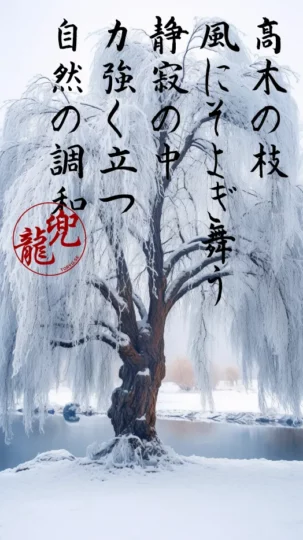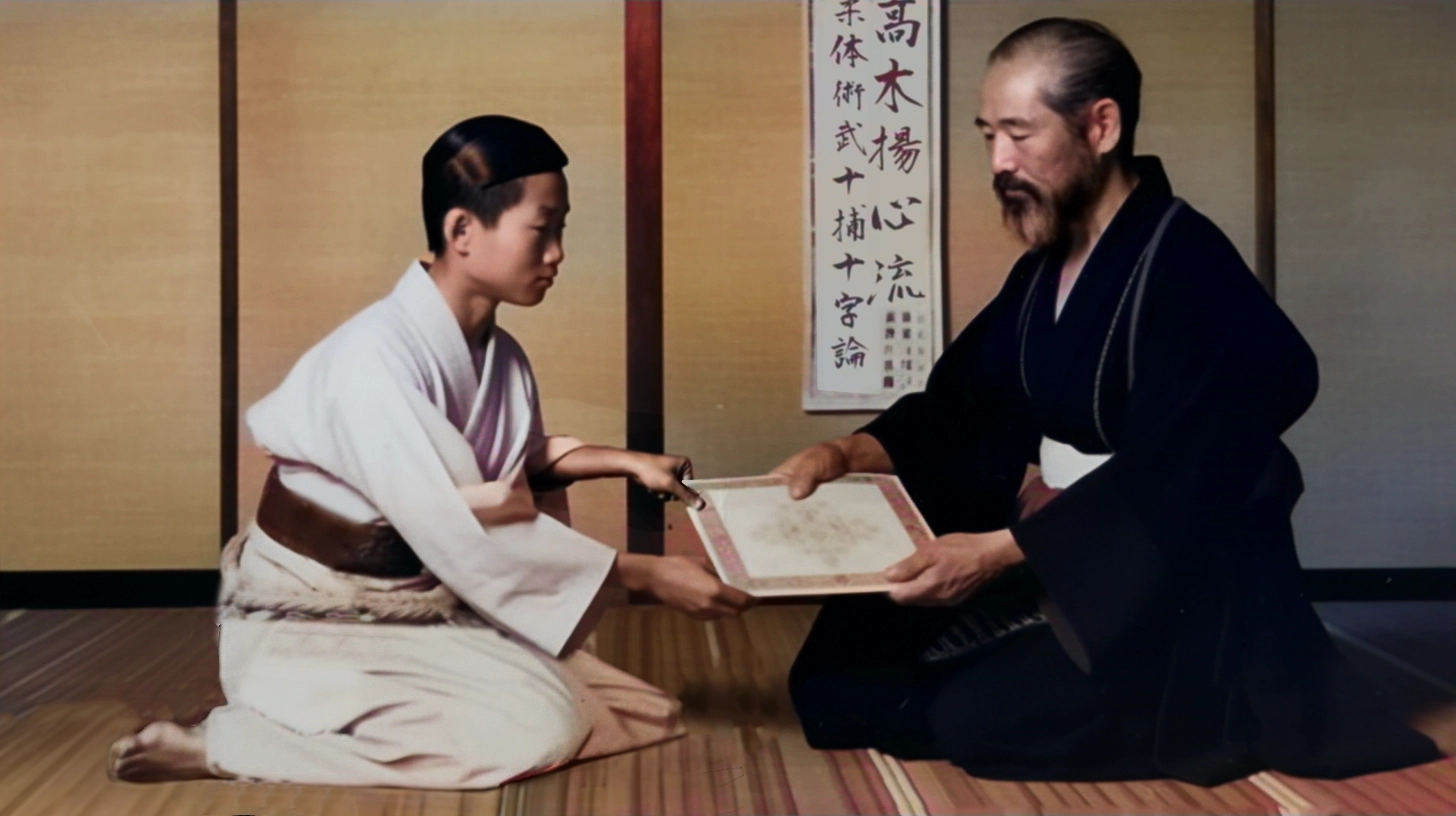高木揚心流柔体術 TAKAGIYŌSHIN-RYŪ JŪTAIJUTSU
高木揚心流 Takagiyōshin-ryū is a jūtaijutsu (jujutsu) school. The techniques are designed to be applied in a very fast manner so the opponent cannot roll or escape.
高 KŌ, taka : tall, high, expensive
木 BOKU, MOKU, ki, gi : tree, wood
揚 YŌ, ageru : raise, elevate, hoist, praise, extol, fry in deep fat
心 SHIN, kokoro : heart, mind, spirit, heart
流 RYŪ, RU, nagare : style, current, flow
柔 YŪ, yawaraka : tender, weakness, gentleness, softness
体 TAI, karada : body, substance, object, reality, counter for images
術 JUTSU, sube : art, technique, skill, means, trick, resources, magic
Branches of the tall tree
Sway and dance in the wind
In tranquil stillness
Standing with strength and might
Harmony with nature

There lived a monk called Abe Unryū at the foot of Mount Funagata in the Rikuzen (now Miyagi prefecture) around 1569-1570. It is said that he was an expert of taijutsu, bōjutsu and shurikenjutsu. He called his teachings Sesshō-hiden. He passed on his teachings to Itō Kii-no-kami Sukesada.
Ito Kii-no-kami Sukesada created his own style that he called Itō-ryū from what he learned from Unryū and his own experiences. His style consisting use of spear, naginata, hanbō, sword and short sword techniques. In the second year of Shōhō (around 1645) he gave menkyō-kaiden to his student Takagi Oriemon Shigenobu.
IMPORTANT MASTERS IN TAKAGIYŌSHIN-RYŪ
1. 高木折右衛門重俊 Takagi Oriemon Shigenobu (born 1625 or 1635) was a samurai of the Shiraishi domain in Ōshu (today Miyagi Prefecture). He was the second son of Inatō Sanzaemon who was a sword instructor and retainer of the Katakura Kojūrō. At a young age he traveled to Akita in Yamagata prefecture to study short sword techniques of the Mutō-ryū and spear techniques from Kyōchi-ryū. He travelled around Japan for 7 years on his Musha Shugyō, before returning back home to Shiraishi. After this he kept the Sumō torikumi (grappling bouts) in mind and developed 12 omote techniques, 24 ura techniques and 12 sabaki techniques and called his style Takagi-ryū. In the eleventh year of the Kanbun reign (1671) he passed on his style which also included jūjutsu, bōjutsu, sōjutsu and naginatajutsu to his adopted son Takagi Umanosuke Shigesada.
2. 高木馬の輔重貞 Takagi Umanosuke Shigesada was born in 1656. He had a duel with Takenouchi Kaganosuke Hisayoshi the third sōke of Takenouchi-ryū and lost. After this he became his student and studied their Koshi-no-mawari which he included in his own style that he named Takagiyōshin-ryu. He passed on his teachings to his son Takagi Gennoshin Hideshige.
3. 高木源之進英重 Takagi Gennoshin Hideshige had a friendly match with Ōkuni Kihei Shigenobu who was the 15’th sōke of Kukishin-ryū. It turned out that Takagi-ryū had better jūjutsu and Kukishin-ryū had better weapon techniques. They decided that it was necessary for both schools to adapt their respective schools’ curricula. Some years later Gennoshin fell ill and died young.
4. 大国鬼平重信 Ōkuni Kihei Shigenobu taught both schools and passed them on to his son Ōkuni Yakuburō Nobutoshi and Ōtone Sakon Yasumasa, the 16’th Sōke in our Kukishin-ryū lineage. Both schools was transmitted together for the following generations until this day.
13. 八木幾五郎久喜 Yagi Ikugorō Hisayashi was a samurai of the Akō domain. He had three students that he passed on his teachings to. They where Fujita Fujigorō Hisayoshi, Ishitani Takeo Masatsugu, and Inoue Yūtarō (or Kumatarō).
16. 高松寿嗣翊翁 Takamatsu Toshitsugu Uō received Menkyō-kaiden from Mizuta Yoshitaro Tadafusa in 1901 when he was only 13 years old. Takamatsu also learned and inherited both lines of Takaigiyōshin-ryu where they had been split around 200 years earlier by Ōkuni Kihe from Ishitani who also was the shihanke of Kukishin-ryū.
17. 初見良昭 Hatsumi Masaaki was appointed the next sōke for the Mizuta line (see below) by Takamatsu. He was also taught the Ishitani line (see Kukishin-ryū) of Takagiyōshin-ryu from Takamatsu.

傳系 TAKAGIYŌSHIN-RYŪ DENKEI (水田伝 – Mizuta den)
[kanji?]
[kanji?]
1. 高木折右衛門重俊
2. 高木馬の輔重貞
3. 高木源之進英重
4. 大国鬼平重信
5. 大国八九郎伸俊
6. 大国太郎太夫忠信
7. 大国鬼兵衛良貞
8. 大国与左衛門良貞
9. 中山甚内定秀
10. 大国武左衛門英信
11. 中山嘉衛門定賢
12. 大国鎌治英俊
13. 八木幾五郎久喜
14. 藤田藤五郎久吉
15. 水田芳太郎忠房
16. 高松寿嗣翊翁
17. 初見良昭
18. 逆井則男
Abe Unryū (Yeiroku era 1568-1579)
Itō Kii-no-kami (Morisada or Sukesada)
Takagi Oriemon Shigenobu (b. 1625 or 1635 – d.1711-10-07)
Takagi Umanosuke Shigesada (b. 1655 – d. 1746)
Takagi Gennoshin Hideshige (d. 1702)
Ōkuni Kihei Shigenobu (Genroku era 1688)
Ōkuni Yakuburō Nobutoshi
Ōkuni Tarodayu Tadanobu
Ōkuni Kihei (Kihyō) Yoshisada
Ōkuni Yozaemon Yoshisada
Nakayama Jinnai Sadahide
Ōkuni Takezaemon Hidenobu
Nakayama Kaemon Sadasaka
Ōkuni Kamaharu Hidetoshi
Yagi Ikugorō Hisayashi (Tempo era 1830-1844)
Fujita Fujigorō Hisayoshi
Mizuta Yoshitarō Tadafusa
Takamatsu Toshitsugu Uō (b. 1887 – 1972)
Hatsumi Masaaki (b. 1931 – present)
Sakasai Norio (2020 – present)
– Some of the sources is from the book Classical Fighting Arts of Japan: A Complete Guide to Koryu Jujutsu (Bushido–The Way of the Warrior)
– Thanks to Eric Weil for the corrections!
– Some sources is from Budō Shiraishi Ei books originally written by Mamiya Hyoemon as Takagi Oriemon telling his stories to Lord Katakura returning from his Musaha Shugyō.
Pingback: KGZ Februari 2010 tema = Takagiyōshin-ryū + Bōjutsu | Kaigōzan dōjō